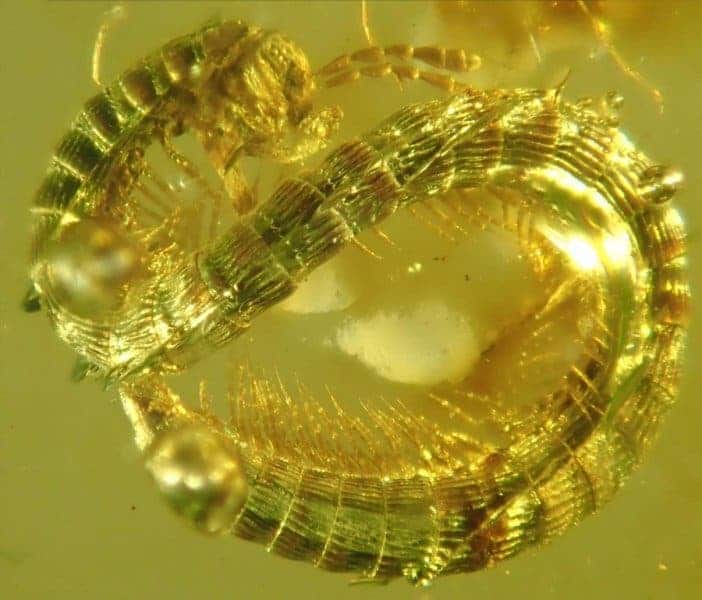Researchers have found the earliest-known millipede, tucked away in a piece of Burmese amber.

Image credits Leif Moritz.
Measuring a full 8.2 millimeters, the fossil millipede is the earliest discovered member of the entire order, a new paper reports. The new species, despite having lived alongside the Cretaceous megafauna, is smaller than any of the extant members of its group. Because of its extraordinary morphology, it is described as a new suborder.
Humble origins
“We were so lucky to find this specimen so well preserved in amber,” says lead author Prof. Pavel Stoev of the National Museum of Natural History (Bulgaria). “With the next-generation micro-computer tomography (micro-CT) and the associated image rendering and processing software, we are now able to reconstruct the whole animal and observe the tiniest morphological traits which are rarely preserved in fossils.”
“It came as a great surprise to us that this animal cannot be placed in the current millipede classification. Even though their general appearance have remained unchanged in the last 100 million years, as our planet underwent dramatic changes several times in this period, some morphological traits in Callipodida lineage have evolved significantly.”
The diminutive critter was recently found in a piece of 99-million-year-old amber in Myanmar. 3D X-ray microscopy revealed that it is the first fossil millipede of the order Callipodida to ever have been discovered, as well as the smallest among its relatives today. The team used this approach to generate cross-section ‘slices’ through the specimen and record every detail of its anatomy — which would normally not be preserved in fossils. A 3D model of the animal, christened Burmanopetalum inexpectatum, is also available in the research article.
This specimen provides the earliest evidence about the age of the order Callipodida, suggesting that this millipede group evolved at least some 100 million years ago. However, its morphology is drastically different from contemporary millipedes. As a result, Prof. Stoev together with his colleagues Dr. Thomas Wesener and Leif Moritz of the Zoological Research Museum Alexander Koenig (Germany) had to revise the current millipede classification and introduce a new suborder — one of only a handful of such cases in the last 50 years.
The anthropod was found amongst roughly 529 millipede specimens, but it was the only one of its order — its name reflects that. The generic epithet (Burmanopetalum) refers to the country of discovery (Myanmar, formerly Burma) and “inexpectatum” means “unexpected” in Latin.
C adds:
“We are grateful to Patrick Müller, who let us study his private collection of animals found in Burmese amber and dated from the Age of Dinosaurs,” says co-author Dr. Thomas Wesener. “His is the largest European and the third largest in the world collection of the kind. We had the opportunity to examine over 400 amber stones that contain millipedes.”
” Many of them are now deposited at the Museum Koenig in Bonn, so that scientists from all over the world can study them. Additionally, in our paper, we provide a high-resolution computer-tomography images of the newly described millipede. They are made public through MorphBank, which means anyone can now freely access and re-use our data without even leaving the desk.”
The paper “Dwarfs under dinosaur legs: a new millipede of the order Callipodida (Diplopoda) from Cretaceous amber of Burma” has been published in the journal ZooKeys.


